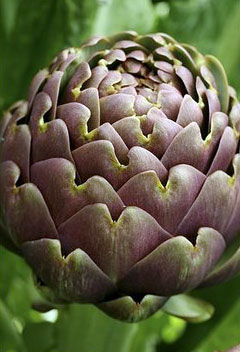 My first foray into a closer relationship with artichokes began as a work assignment. Drive to Lompoc, California, chat with a farmer, get some pictures and get back to Los Angeles without becoming a part of the daily human-and-metal gridlock. Coffee in hand, I raced up the 5, beating traffic and made it with a few minutes to spare.
My first foray into a closer relationship with artichokes began as a work assignment. Drive to Lompoc, California, chat with a farmer, get some pictures and get back to Los Angeles without becoming a part of the daily human-and-metal gridlock. Coffee in hand, I raced up the 5, beating traffic and made it with a few minutes to spare.
Until that point, I categorized artichokes as one of those foods shrouded in history, enjoyed by Romans and Greeks but not necessarily an everyday part of my kitchen. Spiky, thorny, gorgeous yet inhospitable, my little mind was about to be opened to the joys of this thistle.
I spent the day with Steve Jordan. Steve is a man who knows his chokes. In fact, his level of knowledge is quite intimidating. Serious, polite and quiet, Steve is a forth generation California farmer who has been growing artichokes for over twenty years. California grows the majority of artichokes consumed in the United States, and they’ve been grown here since the 1800s when Italian immigrants brought them to the west. The coastal weather of areas like Lompoc and Castroville are perfect for artichokes, and here they thrive like crazy.

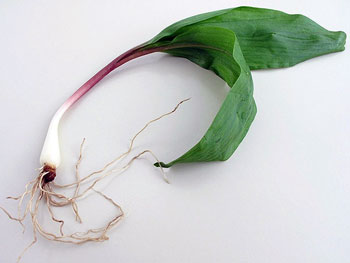 Every year with the arrival of spring comes the short-lived season of ramps. From about April to May ramps are available in farmers' markets in the Northeast. Here people go crazy over ramps. Sometimes I wonder why they're loved so much. Last year I cooked and pickled ramps for the first time and grew very fond of them. Ramps are unique in that they're harvested from the wild. If you know where to find them or know of a forager who can find them for you, then you're very lucky to get them for free. But the rest of us have to buy them at the market.
Every year with the arrival of spring comes the short-lived season of ramps. From about April to May ramps are available in farmers' markets in the Northeast. Here people go crazy over ramps. Sometimes I wonder why they're loved so much. Last year I cooked and pickled ramps for the first time and grew very fond of them. Ramps are unique in that they're harvested from the wild. If you know where to find them or know of a forager who can find them for you, then you're very lucky to get them for free. But the rest of us have to buy them at the market.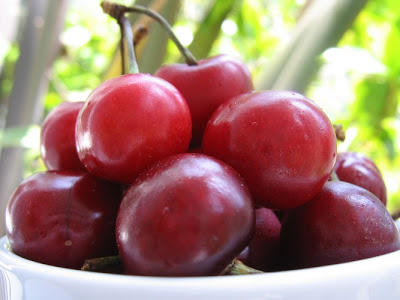 I think most people who shop at farmers’ markets are willing to pay a little more for produce because it’s fresher. There are certain items, however, that are notorious for causing people to balk, such as passionfruit, figs, and, currently, cherries.
I think most people who shop at farmers’ markets are willing to pay a little more for produce because it’s fresher. There are certain items, however, that are notorious for causing people to balk, such as passionfruit, figs, and, currently, cherries.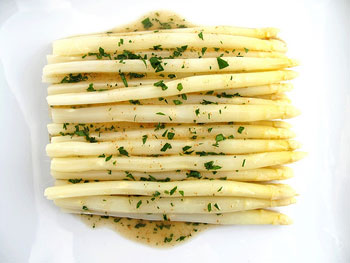 Everyone knows green asparagus—it's making an appearance right now in the markets, announcing that spring has arrived. But not everyone knows white asparagus. It rarely shows up in the market because it's such a specialty but it's definitely worth searching for. Not only does the color (or absence of) make it unique, its flavor is more delicate and milder than green asparagus. But why is it white?
Everyone knows green asparagus—it's making an appearance right now in the markets, announcing that spring has arrived. But not everyone knows white asparagus. It rarely shows up in the market because it's such a specialty but it's definitely worth searching for. Not only does the color (or absence of) make it unique, its flavor is more delicate and milder than green asparagus. But why is it white?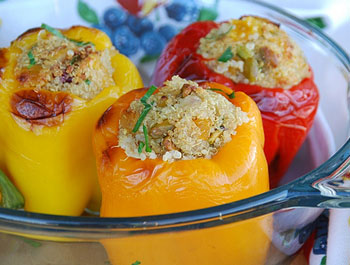 When I first wrote about quinoa two years ago, many of you empathized. You too had gone to a supermarket and asked someone where you could find the kwi-NO-ah. Not anymore. Quinoa (pronounced keen-WAH) is no longer just the baby of vegans; it has gone mainstream.
When I first wrote about quinoa two years ago, many of you empathized. You too had gone to a supermarket and asked someone where you could find the kwi-NO-ah. Not anymore. Quinoa (pronounced keen-WAH) is no longer just the baby of vegans; it has gone mainstream.